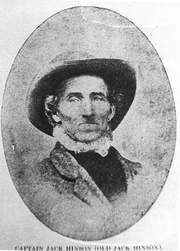Jack Hinson
John W. "Jack" Hinson, "Old Jack" (c. 1807 – 28 April 1874)[1] was a farmer in Stewart County, Tennessee, who operated as a Confederate partisan sniper in the Between-the-Rivers region of Tennessee and Kentucky during the American Civil War.

Biography
A modest land and slave-owner[2] of Scotch-Irish descent, Hinson voted for secession from the Union in both the February and June, 1861 elections [3]. He had welcomed Union General Ulysses S. Grant to his home when Grant was in the area during the Union attack on Forts Henry and Donelson in February 1862. However, Hinson took up arms after his family was ill-treated, two of his sons decapitated, and the remainder of his family turned out of their home by Federal troops without any compensation, later in 1862. The house was later burned.[4] On December 31, 1862, Hinson killed his neutral neighbor, Swiss immigrant Albert Rougemont, with whom he had had a long-running argument for years before the war, and whom he blamed for his house having been burned. The murder was investigated by the Union Provost Marshal, with many of Hinson's neighbors attesting to his decades of violence before the war and his well-known 'Secesh' position at the outset of the war. The verdict of the Provost Marshal was not recorded.[5]
For the remainder of the war, Hinson used a 50 caliber Kentucky long rifle to conduct a personal war against the Union Army. He targeted Union soldiers at distances as great as half-mile on land and on military transports and gunboats on the Tennessee River and the Cumberland River. Hinson is credited with as many as one hundred kills, although his rifle had only 36 notches on it. (The notches were said to be for officers.)[6]
Hinson served as a guide for Nathan Bedford Forrest during his successful cavalry raid on the Union supply base at Johnsonville, Tennessee in November 1864. Hinson's son Robert led a guerrilla band in the area until he was killed in action on September 18, 1863. Hinson himself evaded capture, despite elements of four Union regiments being assigned at different times to pursue him.
He lived the rest of his life peacefully, mostly in Stewart County, settling the estate of his son George, voting, paying his taxes, etc., but also getting into some legal trouble as he had often done before the war.[7] In 1867, he sold 7 acres of timber off of his "Bubbling Springs" farm to the first Superintendent of the new National Cemetery.[8]
Hinson died on April 28, 1874 at his residence in the White Oak/Magnolia area of Houston County, Tennessee. On the morning of his death, he complained of a severe pain between the shoulders. Remedies were applied, but no relief came and he died six hours after being taken. The attack was supposed to be meningitis. He is buried in the family plot in the Cane Creek Cemetery, off White Oak Road, near McKinnon, Tennessee. A monument to him is also located in the Boyd Cemetery in the Land-Between-the Lakes area. His 1874 obituary stated that he was interred at the Boyd Cemetery.[9] Area newspapers in 1873 had been full of stories about the pursuit and capture of "Captain Jack", but those references are to Modoc chief Kintpuash, not to Hinson.
Hinson is commemorated in a roadside marker just across the state border in Kentucky,[10] and his story has been told in two books by Tom McKenney:
- Battlefield Sniper: Over 100 Civil War Kills, Tom C. Lt. Col. McKenney[11]
- Jack Hinson's One Man War.[12]
References
- "Find A Grave: Jack Hinson". Find A Grave. Archived from the original on 2020-03-15.
- Stewart County tax records, Stewart County Archives, Dover, TN, and 1860 Federal Slave Census (accessed at FamilySearch.org)
- Stewart County election returns, Stewart County Archives, Dover, TN
- "Captain John Hinson". The Daily Huntsville Confederate. 9 September 1863. Retrieved 7 May 2019.
- File 04220, United States Union Provost Marshal Files of Two or More Civilians, 1861-1866." Images. FamilySearch. http://FamilySearch.org : 14 June 2016. Citing NARA microfilm publication M416. Washington D.C.: National Archives and Records Administration, n.d.
- Pettit, Carl (June 16, 2016). "The Sniper Who Slayed More than 100 Union Soldiers". OZY. OZY Media. Retrieved June 16, 2016.
- Stewart Circuit Court Loose Records, Stewart County Archives, Dover, TN.
- Stewart County Deed Book 23, page C; original at Stewart County Courthouse, Dover, TN, also accessible on FamilySearch.org
- "Captain Jack Hinson". Clarksville Weekly Chronicle. 16 May 1874. Retrieved 7 May 2019.
- ""Civil War Sniper (Jack Hinson) Historical Marker"". Archived from the original on 2010-11-21. Retrieved 2010-11-09.
- "Battlefield Sniper - Over 100 Civil War Kills, Lt. Col. Tom C. McKenney". Retrieved June 16, 2016.
- McKenney, Tom. Jack Hinson's One Man War. Pelican Publishing Company, 2009.